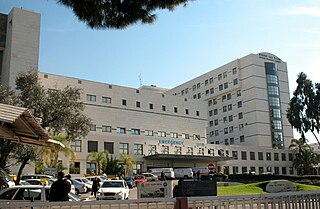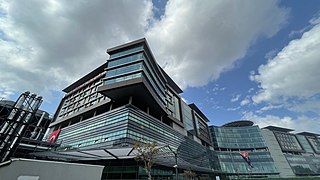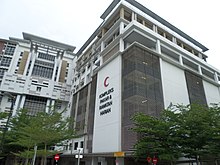Mark Douglas Britnell is an English business executive. He was a senior partner at the professional services firm KPMG and is a global healthcare expert. He was the chairman and senior partner for healthcare, government and infrastructure at KPMG International until September 2020.
The healthcare reform in China refers to the previous and ongoing healthcare system transition in modern China. China's government, specifically the National Health and Family Planning Commission, plays a leading role in these reforms. Reforms focus on establishing public medical insurance systems and enhancing public healthcare providers, the main component in China's healthcare system. In urban and rural areas, three government medical insurance systems—Urban Residents Basic Medical Insurance, Urban Employee Basic Medical Insurance, and the New Rural Co-operative Medical Scheme—cover almost everyone. Various public healthcare facilities, including county or city hospitals, community health centers, and township health centers, were founded to serve diverse needs. Current and future reforms are outlined in Healthy China 2030.
Healthcare in Algeria consists of an established network of hospitals, clinics, and dispensaries. The government provides universal health care.

Healthcare in Israel is universal and participation in a medical insurance plan is compulsory. All Israeli residents are entitled to basic health care as a fundamental right. The Israeli healthcare system is based on the National Health Insurance Law of 1995, which mandates all citizens resident in the country to join one of four official health insurance organizations, known as Kupat Holim which are run as not-for-profit organizations and are prohibited by law from denying any Israeli resident membership. Israelis can increase their medical coverage and improve their options by purchasing private health insurance. In a survey of 48 countries in 2013, Israel's health system was ranked fourth in the world in terms of efficiency, and in 2014 it ranked seventh out of 51. In 2020, Israel's health system was ranked third most efficient in the world. In 2015, Israel was ranked sixth-healthiest country in the world by Bloomberg rankings and ranked eighth in terms of life expectancy.

Healthcare in Singapore is under the purview of the Ministry of Health of the Government of Singapore. It mainly consists of a government-run publicly funded universal healthcare system as well as a significant private healthcare sector. Financing of healthcare costs is done through a mixture of direct government subsidies, compulsory comprehensive savings, national healthcare insurance, and cost-sharing.

Healthcare in Turkey consists of a mix of public and private health services. Turkey introduced universal health care in 2003. Known as Universal Health Insurance Genel Sağlık Sigortası, it is funded by a tax surcharge on employers, currently at 5%. Public-sector funding covers approximately 75.2% of health expenditures.

Government expenditure on healthcare was about 3.1% of its total gross domestic product in 2018.

Healthcare in South Korea is universal, although a significant portion of healthcare is privately funded. South Korea's healthcare system is based on the National Health Insurance Service, a public health insurance program run by the Ministry of Health and Welfare to which South Koreans of sufficient income must pay contributions in order to insure themselves and their dependants, and the Medical Aid Program, a social welfare program run by the central government and local governments to insure those unable to pay National Health Insurance contributions. In 2015, South Korea ranked first in the OECD for healthcare access. Satisfaction of healthcare has been consistently among the highest in the world – South Korea was rated as the second most efficient healthcare system by Bloomberg. Health insurance in South Korea is single-payer system. The introduction of health insurance resulted in a significant surge in the utilization of healthcare services. Healthcare providers are overburdened by government taking advantage of them.

Healthcare in Thailand is overseen by the Ministry of Public Health (MOPH), along with several other non-ministerial government agencies. Thailand's network of public hospitals provide universal healthcare to all Thai nationals through three government schemes. Private hospitals help complement the system, especially in Bangkok and large urban areas, and Thailand is among the world's leading medical tourism destinations. However, access to medical care in rural areas still lags far behind that in the cities.
Healthcare in Finland consists of a highly decentralized three-level publicly funded healthcare system and a much smaller private sector. Although the Ministry of Social Affairs and Health has the highest decision-making authority, specific healthcare precincts are responsible for providing healthcare to their residents as of 2023.
In South Africa, private and public health systems exist in parallel. The public system serves the vast majority of the population. Authority and service delivery are divided between the national Department of Health, provincial health departments, and municipal health departments.
Healthcare in Georgia is provided by a universal health care system under which the state funds medical treatment in a mainly privatized system of medical facilities. In 2013, the enactment of a universal health care program triggered universal coverage of government-sponsored medical care of the population and improving access to health care services. Responsibility for purchasing publicly financed health services lies with the Social Service Agency (SSA).

Healthcare in Denmark is largely provided by the local governments of the five regions, with coordination and regulation by central government, while nursing homes, home care, and school health services are the responsibility of the 98 municipalities. Some specialised hospital services are managed centrally.

Examples of health care systems of the world, sorted by continent, are as follows.
Government-guaranteed health care for all citizens of a country, often called universal health care, is a broad concept that has been implemented in several ways. The common denominator for all such programs is some form of government action aimed at broadly extending access to health care and setting minimum standards. Most implement universal health care through legislation, regulation, and taxation. Legislation and regulation direct what care must be provided, to whom, and on what basis.
According to the Malaysia Healthcare Travel Council (MHTC), Malaysia reportedly received 641,000 foreign patients in 2011, 728,800 in 2012, 881,000 in 2013, 882,000 in 2014, 859,000 in 2015, and 921,000 in 2016. Malaysia's medical tourism statistics derive from the reported numbers of all foreign patients treated by MHTC-endorsed medical facilities. These figures encompass all registered patients with a foreign passport, which by default also encompass expatriates, migrants, business travellers, and holiday-makers for whom health care may not be the main motive for their stay. The number of MHTC-endorsed medical facilities in Malaysia has increased over the years, playing a role in increasing the official figures on foreign patients. Malaysia is listed in the top 10 tourism destinations in the world by Patients Beyond Borders.

India has a multi-payer universal health care model that is paid for by a combination of public and government regulated private health insurances along with the element of almost entirely tax-funded public hospitals. The public hospital system is essentially free for all Indian residents except for small, often symbolic co-payments in some services. Economic Survey 2022-23 highlighted that the Central and State Governments’ budgeted expenditure on the health sector reached 2.1% of GDP in FY23 and 2.2% in FY22, against 1.6% in FY21. India ranks 78th and has one of the lowest healthcare spending as a percent of GDP. It ranks 77th on the list of countries by total health expenditure per capita.

Healthcare in Belize is provided through both public and private healthcare systems. The Ministry of Health (MoH) is the government agency responsible for overseeing the entire health sector and is also the largest provider of public health services in Belize. The MoH offers affordable care to a majority of Belizeans with a strong focus on providing quality healthcare through a range of public programs and institutions.

The Egyptian healthcare system is pluralistic, comprising a variety of healthcare providers from the public as well as the private sector. The government ensures basic universal health coverage, although private services are also available for those with the ability to pay. Due to social and economic pressures, Egypt's healthcare system is subject to many challenges. However, several recent efforts have been directed towards enhancing the system.
Healthcare standards in Qatar are generally high. Qatari citizens are covered by a national health insurance scheme, while expatriates must either receive health insurance from their employers, or in the case of the self-employed, purchase insurance. Qatar's healthcare spending is among the highest in the Middle East, with $4.7 billion being invested in healthcare in 2014. This was a $2.1 billion increase from 2010. The premier healthcare provider in the country is the Hamad Medical Corporation, established by the government as a non-profit healthcare provider, which runs a network of hospitals, an ambulance services, and a home healthcare service, all of which are accredited by the Joint Commission.













